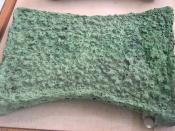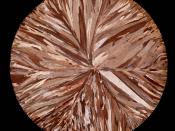Once man had learned to use stone he seemed content to stick with this single method of tool making for thousands of years. Stone was plentiful, relatively easy to work with, and seemed to satisfy his needs.
Finally, around 3500 B.C. man ventured into the Age of Metal. The first metal which he learned to work was copper. This metal is extremely soft, melts easily in a simple campfire and can be worked into tools with relative ease. Copper make tools of a poor quality. Because copper is soft (have you ever tried to bend copper electrical wire?) it will not hold an edge (stay sharp) for any length of time. Copper knives could be made, but the simple act of cutting animal flesh instantly dulled the blade and it had to be reformed. Copper was used to make jewelry, copper beads could easily be strung together to make a necklace.
Copper was probable first discovered as beads which leaked out of rocks used to surround campfires. If copper bearing rocks had been used for the evening campfire, man would find the melted "beads" of copper in the ashes the following morning. Copper was superior to most stone tools, but still not dependable.
About 2500 B.C. man moved to the second Age of Metal, the Bronze Age. Bronze is not an element but rather an alloy being made of both copper and tin. Both metals are relatively soft is used alone, but when blended together they form a compound which is far more durable than either alone. Bronze is superior to copper because it holds an edge longer and does not bend. The drawback to bronze is that it is extremely brittle and breaks or cracks easily. Thus a bronze spear head will kill an animal if you strike...


